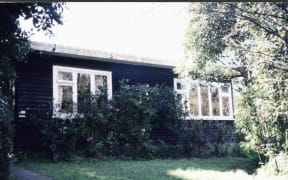6. Canvases
Credits
(1) Joyce Hamilton: Growing up at Drysdale. Underscored by Soundscape with Lake and River (electronic, 1979) [SA/NTK 14535].
(2) Peter Vere-Jones: "Sunlight, and happiness again …" - reading from Douglas’s unpublished notes for Memories of Early Years - a selection of autobiographical sketches [MS-Papers-7623-025].
(3) Music: Leaving the Hermitage from the National Film Unit production of Journey For Three (1948), recorded in 1948 [SA/NTK TANZA CL2].
(4) Philip Norman: First musical period. Underscored and followed by Aotearoa Overture (1940), performed by the New Zealand Symphony Orchestra conducted by Michi Inoue, recorded in 1979 [SA/NTK 14261].
(5) John Hopkins: Landscapes in Douglas's music, the clear light. Underscored and followed by Aotearoa Overture (1940), performed by the New Zealand Symphony Orchestra conducted by Michi Inoue, recorded in 1979 [SA/NTK 14261].
(6) John Rimmer: Spaciousness in Douglas’s music, the sea. Underscored by Three Inscapes (electronic, 1972) [SA/NTK 14417].
(7) Ron Burt: Using imagery to convey meaning to the performer. Underscored and followed by Seventeen Pieces for Guitar (1969-70), performed by Milton Parker (guitar), recorded in 1977 [SA/NTK 14571].
(8) Allen Curnow: The combination of poet and composer combining to form New Zealand identity. Archival talk extracted from Music Ho, Douglas Lilburn 50th Birthday Tribute, recorded in 1965 [SA/NTK CDR-195].
(9) Jack Body and Douglas: Using external influences to construct a national identity. Archival interview recorded in 1975 [SA/NTK 14560].
(10) Audio: Introduction from This is New Zealand (1949), a New Zealand Broadcasting Service radio documentary.
(11) Philip Norman: Writing incidental music for This is New Zealand.
(12) Audio: Brief musical extract from This is New Zealand (1949), a New Zealand Broadcasting Service radio documentary.
(13) Music: Sounds and Distances (electronic, 1975) [SA/NTK 14525].
(14) Peter Vere-Jones: "Pukeroa School …" - reading from Douglas’s unpublished notes for Memories of Early Years - a selection of autobiographical sketches [MS-Papers-7623-025].
(15) John Murray: “A paradise to roam in … living in his own home bush ...”
(16) Alistair Te Ariki Campbell: Douglas's flat on the Avon River, Christchurch.
(17) Joyce Hamilton: Describing Douglas's Christchurch bedsit. Underscored by Quartet for Brass Instruments (1957), performed by Concord Brass - Grant Cooper, Daniel Waldron, Marc Guy and Barry Kilpatrick; recorded in 1989 and Chaconne (1946), performed by Patrick O'Byrne (piano), recorded in 1987 [SA/NTK 14305 and 14454].
(18) Ropata Erwin: First meeting Douglas, walking along the Paekakariki beach.
(19) Audio: A recording of Douglas's alarm system at Ascot Terrace. Archival sound extracted from an interview recorded by Chris Bourke in 1985 for the Listener.
(20) Gwyneth Brown: Describing Ascot Terrace.
(21) Jeannie Lilburn: Describing the interior of Ascot Terrace. Underscored and followed by Diversions for String Orchestra (1947), performed by the Alex Lindsay String Orchestra, recorded in 1956 [SA/NTK 14297].
(22) Chris Bourke: Meeting Douglas for the Listener interview in 1985.
(23) Chris Bourke and Douglas: Reasons for moving into electronic music. Archival interview recorded in 1985 for the Listener.
(24) Douglas Lilburn: Painting with electronic sound. Archival interview recorded in 1975 [SA/NTK 14560].
(25) Philip Norman: Third musical period. Underscored by Soundscape with Lake and River (electronic, 1979) [SA/NTK 14535].
(26) Music: The Return (1965), electronic sound image - poem by Alistair Campbell, read by Tim Elliot, voices by Mahi Potiki [SA/NTK 14384].
(27) Richard Campion and Douglas: “Setting up an electronic music cave ...” - archival interview recorded in 1989 [SA/NTK 14477].
(28) Peter Vere-Jones: Reading from Douglas's published note on the electronic composition Summer Voices. Underscored by Summer Voices (electronic, 1969) [SA/NTK 14555].
(29) Ross Harris: Demonstration of the Synthi AKS ca. 1969.
(30) Ashley Heenan: Giving advice on one of Douglas's early electronic compositions.
(31) Music: Sonata (1950), performed by Ronald Woodcock (violin) and John Wells (piano), recorded in 1975 [SA/NTK 15814].
(32) Dorothy McKegg: Production Credits.
